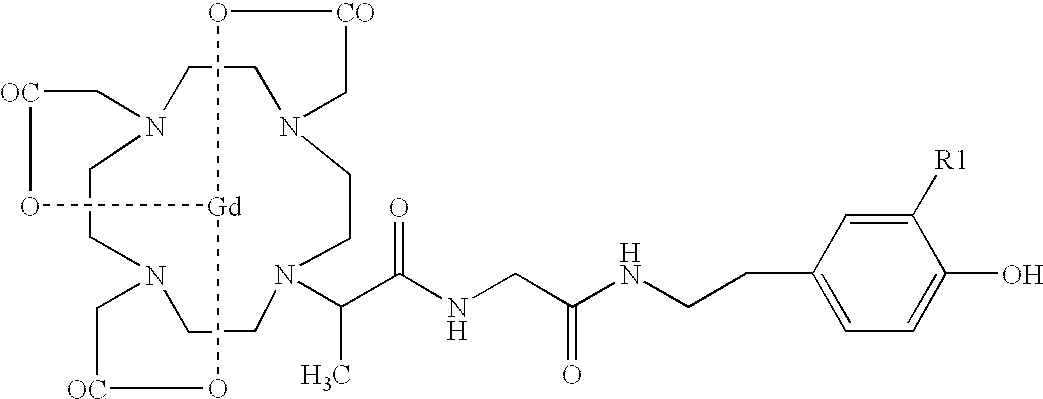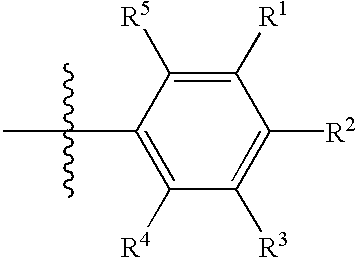Imaging of enzymatic activity
a technology of enzymatic activity and imaging, applied in the field of biochemistry and magnetic resonance imaging, can solve the problems of low signal-to-background ratio, low sensitivity of mri to the presence of magnetic labels, and limited the usefulness of mri for detection and imaging of low-abondan
- Summary
- Abstract
- Description
- Claims
- Application Information
AI Technical Summary
Benefits of technology
Problems solved by technology
Method used
Image
Examples
example 1
[0065] Substrate Synthesis
[0066] Using glycylmethyl-DOTA, tri tBu ester, we linked a carboxyl group of glycine to the amino group of tyramine or dopamine (hydroxytyramine) by reacting equimolar amounts (0.25 mmol) in the presence of 1.1-fold molar excess of dicyclohexylcarbodiimide (FIG. 1) in 2 ml dimethylformamide (DMF) for 24 hours. The reaction mixture was filtered through glass fiber filter, dissolved in 100 ml chloroform and washed with water. The product was recovered by vacuum evaporation and treated with 50% trifluoroacetic acid (TFA) for 1 hour. Deprotected acid was washed with diethyl ether and dried by vacuum evaporation. Crude tyraminyl- or hydroxytyraminyl-glycylmethylDOTA was dissolved in a solution of equimolar amount of Gd citrate (pH 3.5), heated at 75.degree. C. for 1 hour under argon and purified by using a Vydac C-18 HPLC column eluted by a gradient of acetonitrile in 0.1% TFA. The major peak at 280 nm was collected and dried. Analysis of the free acid by matrix...
example 2
[0067] Cell Culture
[0068] Human umbilical vein endothelial cells (Endothelial Biology, Brigham and Women's Hospital, Boston, Mass.) were isolated using conventional techniques (see, e.g., Saba et al., Series Haematologica 6:456). Cells were plated on gelatin-covered plastic and cultured in 10%fetal bovine serum (FBS) in endothelial basal medium (EDM) (Clonetics) with endothelial growth supplements. Treatment of cells with human recombinant IL-1.beta. (10 pg / ml) was performed at 37.degree. C. for 4 hours. E-selectin expression on the surface of IL-1.beta. treated cells has been proven by fluorescent microscopy using monoclonal anti-human E selectin antibody H18 / 7 (Vascular Research Dept. of Pathology, Brigham and Women's Hospital, Boston, Mass.), followed by anti-mouse-rhodamine conjugate (Pierce Chem. Co.).
example 3
[0069] Peroxidase Catalysis and Imaging
[0070] Substrates I and II at concentrations of 10-50 .mu.M were treated by peroxidase (0.1-100 nM) and an excess of hydrogen peroxide (3.5 mM) in 10 mM phosphate-buffered saline (PBS) or 0.05 M sodium phosphate pH 6.8. In some experiments, a peroxide-generating system (5 mM glucose, glucose oxidase and lactoperoxidase) was used. In inhibition studies, 2 mM Gd-free substrate, tyramine, dopamine, or methyldopamine were added as competitive inhibitors. The reaction was monitored by spectrophotometry at 400 nm and by NMR spectrometry (Minispec 120 Bruker). Magnetic resonance imaging was performed using a 1.5 T Signa GE system and surface or knee coils. Inversion-recovery pulse sequences (TE 11 ms / TR 1000 ms / TI 50-600 ms) were used for T1 measurements. Spin-echo sequence (TE 13ms / TR 400 ms / 2 NEX, Matrix 256.times.160) was optimal for magnetic resonance imaging of signal amplification. Magnetic resonance signal intensity was measured using region-of...
PUM
| Property | Measurement | Unit |
|---|---|---|
| pH | aaaaa | aaaaa |
| pH | aaaaa | aaaaa |
| molecular weight | aaaaa | aaaaa |
Abstract
Description
Claims
Application Information
 Login to View More
Login to View More - R&D
- Intellectual Property
- Life Sciences
- Materials
- Tech Scout
- Unparalleled Data Quality
- Higher Quality Content
- 60% Fewer Hallucinations
Browse by: Latest US Patents, China's latest patents, Technical Efficacy Thesaurus, Application Domain, Technology Topic, Popular Technical Reports.
© 2025 PatSnap. All rights reserved.Legal|Privacy policy|Modern Slavery Act Transparency Statement|Sitemap|About US| Contact US: help@patsnap.com



